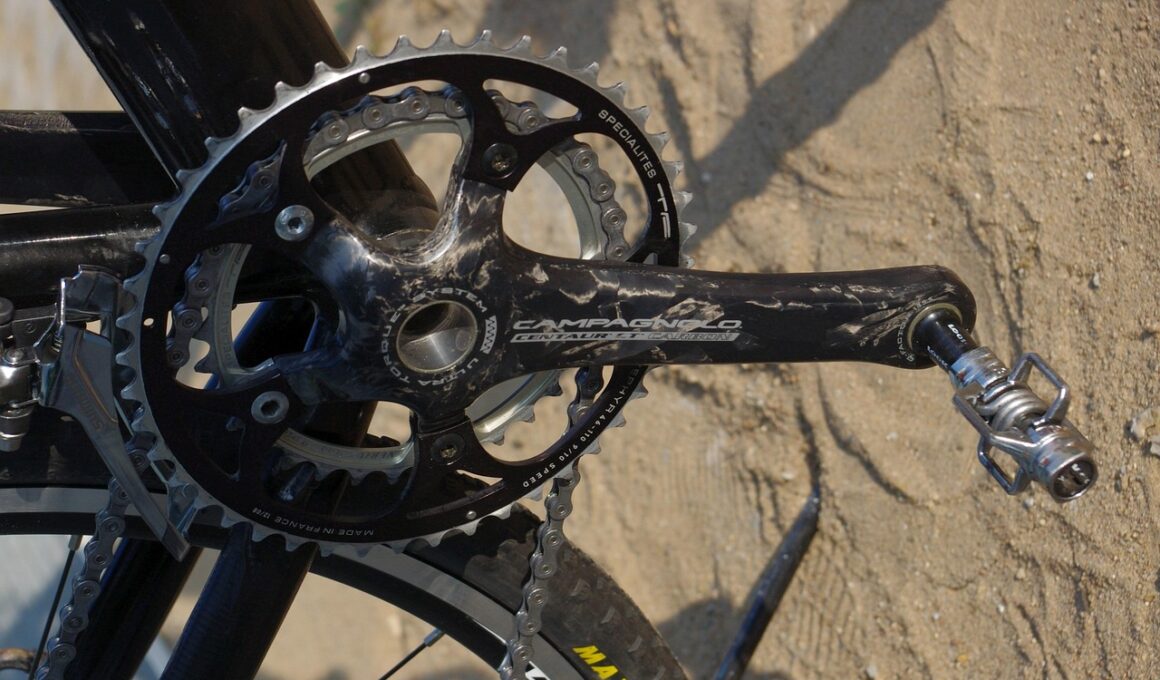The Impact of Weather on Cyclocross Performance
Cyclocross is a unique cycling discipline that tests athletes’ skills in various weather conditions. Understanding how different environmental factors influence performance is crucial to optimizing training and racing strategy. Weather not only affects the terrain but also the tactics used by competitors. For instance, during rainy days, the mud can turn an otherwise fast course into a challenging obstacle. Riders must adapt their techniques and equipment choices to maintain speed and traction. Proper tire selection is essential, allowing for sufficient grip on slippery surfaces. Additionally, the temperature may impact riders’ physical performance; cooler weather can provide an energy boost, while excessively hot or humid conditions may lead to fatigue. Riders must stay hydrated and manage their energy levels effectively in such climates. Moreover, wind speed and direction play a significant role, often affecting race outcomes. Understanding these factors is vital for a successful event. This knowledge can also promote safety and injury prevention while riding through challenging conditions. Experience in handling various weather scenarios allows athletes to perform at their best regardless of the elements they face during competition.
One critical aspect of cyclocross performance influenced by weather is tire selection. The choice of tires can significantly affect grip, speed, and handling on different surfaces. In wet conditions, mud tires with wider treads may provide better grip while navigating through slippery sections. On dry, hard-pack courses, narrower, smoother tires can enhance rolling resistance and speed. Weather conditions can also lead to changes in tire pressure, which must be adjusted for optimal performance. Lower tire pressure can increase traction but may also raise the risk of pinch flats. Conversely, higher pressure can improve speed but diminish grip on technical sections. In addition to tires, the bike setup plays a vital role in handling during adverse weather. Adjustments in the bike’s geometry, such as handlebar height or stem length, may enhance performance as environmental conditions shift throughout the race. Riders should take time during practice sessions to experiment with different setups to find what works best for various weather scenarios. More experienced cyclists often develop personal preferences regarding these adjustments to optimize how they navigate courses, enabling them to race effectively.
Training for Varied Weather Conditions
Training in diverse weather conditions is essential for any cyclocross athlete. Exposure to various environmental scenarios not only improves physical conditioning but also builds mental resilience. Cyclocross enthusiasts often encounter unpredictable weather during races; therefore, simulating these conditions in training ensures that riders can respond appropriately. Riding in rain or snow develops adaptability and improves bike handling skills in slippery or unstable terrains. For example, practicing cornering on wet surfaces teaches cyclists to adjust their approach to maintain speed while ensuring control. Additionally, training in cold conditions prepares athletes for the physical and mental challenges that arise in low temperatures. Riders may experience muscle stiffness or reduced energy, necessitating specific strategies to remain warm and focused. Nutrition plays a significant role during these training sessions, as athletes need to consume appropriate foods to maintain energy balance. Hydration remains critical as dehydrated cyclists can struggle to perform during races. Many riders also find value in cross-training activities, such as running or strength training, as a means of enhancing overall performance, building confidence, and preparing for the unpredictable nature of cyclocross.
Races often encounter sudden weather changes that can dramatically alter outcomes. Competitors must be prepared for this unpredictability by adopting adaptable racing strategies. Staying informed about weather forecasts before and during the event is crucial. What starts as a sunny day can quickly shift to rain or hail, affecting surface conditions within minutes. Cyclocross athletes should be ready to adjust their pacing and tactics depending on how the weather impacts their course. In such scenarios, being observant of rivals’ techniques can provide valuable insights into adapting effectively. Successful riders also practice focusing on their bike-handling skills in challenging weather, minimizing mistakes during crucial moments in competition. Embracing the mental aspect of racing is equally important; athletes can strengthen their focus by visualizing different race conditions during training. This practice leads to enhanced confidence when faced with adversity during events. Moreover, learning to manage discomfort in extreme temperatures or wet conditions is vital for staying competitive. Races may push riders to their limits, but mastering the mental game alongside physical conditioning can lead to memorable performances in unpredictable weather.
Equipment Considerations for Adverse Conditions
When facing adverse weather during cyclocross events, riders should have the right equipment to ensure their performance remains uncompromised. Essential gear includes appropriate clothing layers to maintain warmth and dryness throughout evolving conditions. Investing in high-quality waterproof jackets can greatly improve comfort during rainy races. Moreover, thermal base layers help regulate body temperature while keeping athletes warm. Accessories like gloves and headbands are also beneficial, as they help minimize heat loss and protect extremities. Additionally, having reliable bike components is vital to maintain performance in harsh conditions. Fenders may provide protection from mud and rain; lightweight, easily removable models allow for quick setups. Other essential components include robust brake systems that maintain performance during wet weather, ensuring reliable stopping power when needed. Lights or reflectors may also be necessary if races extend into hours with less daylight. Having the right equipment is crucial for safety, promoting better performance while navigating through unpredictable elements. A well-thought-out gear setup helps cyclists overcome challenges and ultimately achieve more satisfying results at the finish line.
Weather conditions can also impact mental preparation leading up to a cyclocross race. The emotional toll of racing in challenging environments may lead to heightened anxiety, making it essential for athletes to develop coping strategies. Maintaining focus can be difficult when the weather doesn’t cooperate as planned. Psyching oneself into a positive mindset ahead of competition is vital for overcoming pressures that may arise from unpredictable situations. Visualization techniques, such as imagining one’s race strategy and how to handle potential obstacles, are useful methods for preparing mentally. Practicing mindfulness and breathing exercises can further enhance mental clarity and composure upon encountering unexpected hurdles. Building a supportive network of fellow cyclists can foster confidence and alleviate stress before races. Sharing stories about dealing with adverse weather can create a sense of camaraderie, strengthening bonds within the cycling community. As the start approaches, reminding oneself of past successes in challenging conditions can provide mental reinforcement. Cultivating a resilient mindset enables riders to face harsh weather with determination and grit, setting them up for success amid adversity.
Conclusion: Embracing Weather Challenges
Ultimately, experiencing varied weather conditions shapes the cyclocross rider’s journey, offering lessons that extend beyond the racecourse. Weather should not be viewed solely as an obstacle; instead, embracing it as a challenge can lead to personal growth as an athlete. Learning to navigate fluctuating climates develops essential bike-handling skills, adaptability, and resilience—qualities that benefit riders both on and off the bike. Competitors who effectively manage the physical and mental aspects of adverse conditions often find a greater sense of accomplishment in their results. As they continue to confront and conquer weather-related challenges, they become better prepared for future races. In time, their experiences will yield a greater understanding of their capabilities and the sport’s unpredictable nature. Each race delivers new opportunities to learn and improve. Cyclocross embodies more than just a race against time; it’s also a test of character and tenacity. Adopting a positive mindset about weather conditions can fuel passion for the sport and inspire riders to face future challenges head-on. Embracing the elements ultimately paves the way for both personal and athletic achievements.
Having summarized the significant impacts of weather on cyclocross, it’s evident that athletes must commit to understanding their environment. The performance is intrinsically linked not only to physical preparation but also to strategic thinking in response to changing weather conditions. This intricate relationship unveils the true nature of cyclocross, where preparation and flexibility rule. Whether encountering heavy rain, freezing temperatures, or unanticipated wind gusts, riders must continually adapt their tactics and mindset. Mastering the fundamentals of bike handling in varying terrains will enhance their enjoyment and performances in any racing scenario. Aspiring cyclocross riders should embrace the unpredictability of weather while also developing their skills and acquiring knowledge on equipment adjustments. Investing time in both physical and mental training transforms challenges posed by weather into opportunities for personal growth. Consequently, these elements converge to foster a holistic approach to mastery in the sport. By fully embracing weather constraints, aspiring cyclocross enthusiasts learn invaluable lessons that extend beyond cycling, instilling valuable traits such as resilience and adaptability. The unpredictable nature of weather makes cyclocross not just a sport, but a journey filled with endless learning potential.


